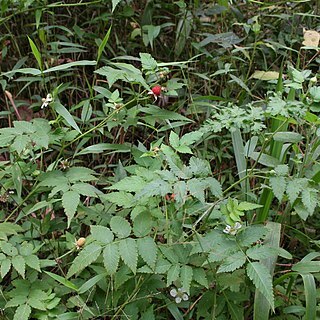A variable sometimes scrambling widely spreading shrub up to 6 m. tall.. Flowering shoots with rather slender, greenish-red or red, subglabrous or tomentose stalks; prickles straight or hooked, glabrous or nearly so, up to 6 mm. long but often considerably less, sometimes congestedly numerous.. Leaves imparipinnate (2–4-jugate) or the uppermost trifoliolate; leaflets rather small, the terminal one often largest, ovate to ovate-lanceolate, 3–6.5 × 1.5–3.3 cm., acute or acuminate, basally rounded to cordate, sharply and sometimes ± deeply (up to 3 mm.) serrate or biserrate, green on both surfaces but paler beneath, usually glabrous but varying to thinly hairy, and usually with pubescent midrib and nerves on the under side.. Inflorescence a rather lax panicle varying from ± slender and cylindrical to stout and broadly pyramidal, up to 35 × 20 cm., with the lowest branchlets 12 cm. long or more; pedicels slender, 7–13 mm. long, tomentose, commonly aculeolate.. Calyx 5–8 mm. long, tomentose, rarely with a few stipitate glands or gland-tipped pricklets, deeply divided into greenish lobes 4–6.5 mm. long, irregularly spreading after anthesis.. Petals (if present) pink or white, ovate, obtuse, 4 × ± 2.5 mm.. Carpels densely tomentose varying to glabrous.. Fruit “yellow, red or rosy,” but probably black when ripe, edible.
Perennial shrub or scrambler, up to 6 m high. Leaves 2-4-jugate or uppermost ones ternate, thinly membranous; lateral leaflets shortly petiolulate, terminal one with petiolule; ovate-acute to oblong-acuminate, margins serrate; glabrous. Stipules narrowly linear, occasionally with a few stipitate glands. Inflorescences terminal and axillary, narrowly pyramidal. Flowers: calyx occasionally glandular-hairy, divided into lanceolate-acuminate lobes; petals usually present although inconspicuous, narrow. Flowering time Aug.-Feb. Fruit globose, glabrous.
Leaflets ovate-acute to oblong-acuminate, with finely serrate margin; superior surface dark green, glabrous; inferior surface pale green, entirely glabrous or villous on main veins, the midrib not or finely aculeate, the lateral veins without prickles.
Leaves 10–19 x 8–12 cm., 2–4-jugate or the uppermost ones ternate, rather thin and membranous in texture; petiole and rhachis aculeate like the stems; lateral leaflets shortly petiolulate, the terminal one with petiolule 0·5–2 cm. long.
A small bush or scrambler. It can grow 3.5 m high. The flowering branches have prickles. The leaves are 10-19 cm long by 8-12 cm wide. They are divided into leaflets. The flower petals are small but pink. The fruit are red.
Flowering branches glabrous or occasionally somewhat tomentose, dark reddish-brown, rarely whitish-pruinose below, with glabrous yellowish or brownish decurved prickles 2–5 mm. long.
Inflorescences terminal and axillary, (3)8–36 cm. long, narrowly pyramidal or pyramidal, usually much longer than the leaves, the branches spreading, greyish-tomentose.
Sprawling, thorny shrub to 2 m. Leaves 5-7-pinnate, leaflets elliptic and toothed. Flowers in small, velvety, terminal panicles, lilac. Fruits orange.
Scandent shrub. Leaves 7-9-foliolate. Leaflets green and glabrous or nearly so on both surfaces. Fruits orange. Flowers pink and mauve.
Calyx greyish-tomentose, very occasionally glandular-hairy, divided into lanceolate-acuminate lobes 5–8 mm. long.
Fruits globose, c. 0·6 mm. long, red when ripe; carpels relatively few (10–35), glabrous.
Petals usually present although inconspicuous, pink, narrow, shorter than the sepals.
Stipules narrowly linear, very occasionally with a few stipitate glands.
Straggling bush or scrambler up to c. 3·5 m. high.

